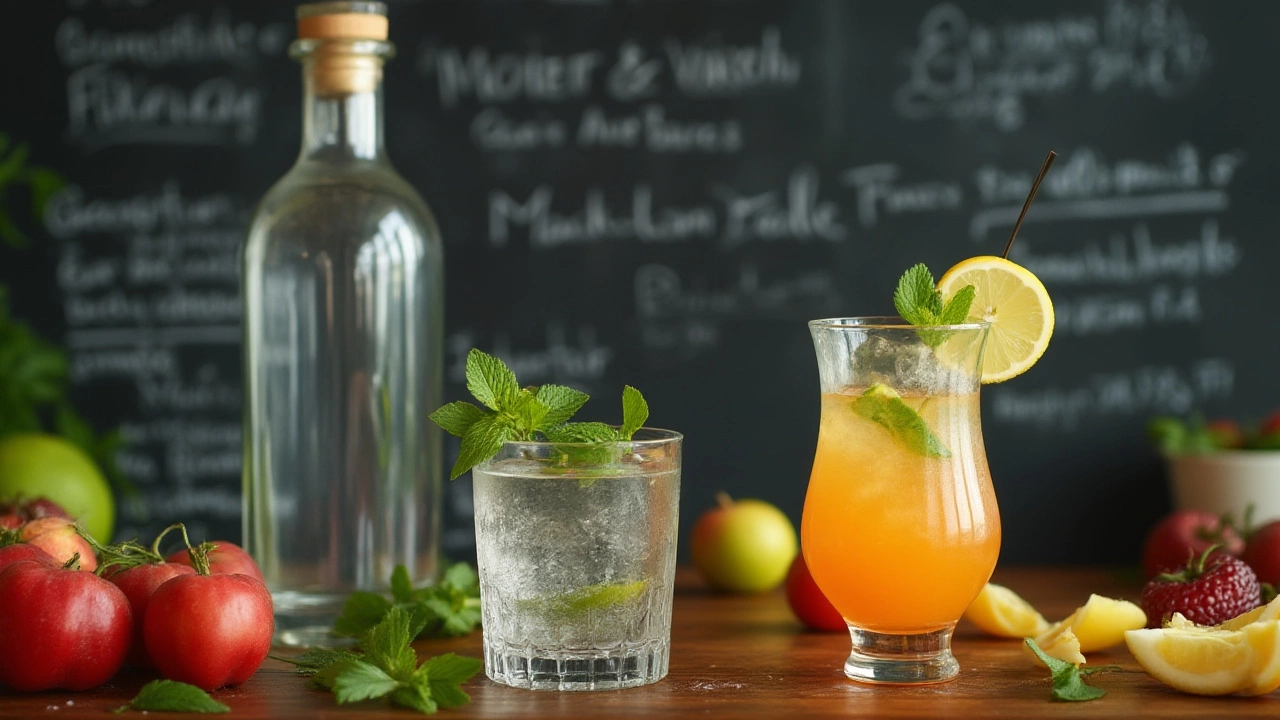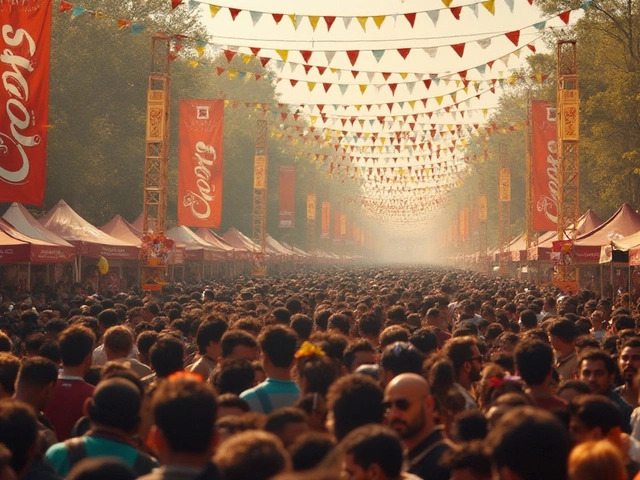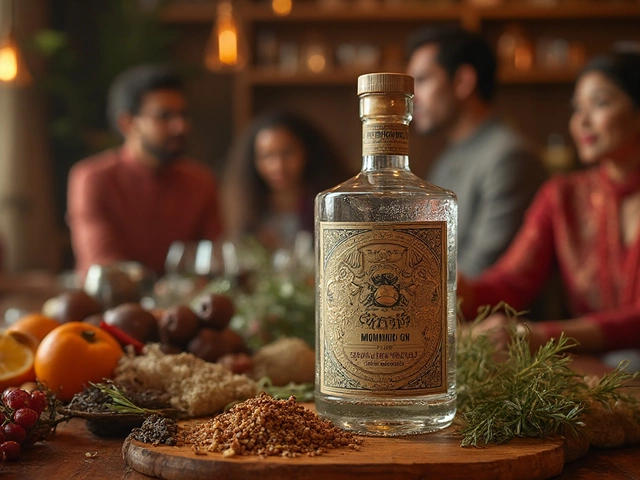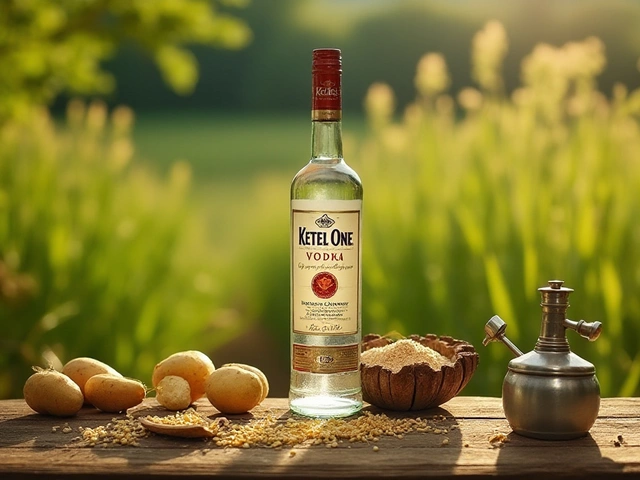
The world is obsessed with counting calories, and for good reason. After all, if you’ve ever held a pint in one hand and a slim martini glass in the other, you might have wondered: which one’s giving my jeans a tighter squeeze? Vodka always seems to win as the "skinny" option, whispered about in gyms and splashed across lifestyle blogs. But is that reputation fair? Or is it just clever marketing in a frosted bottle?
The Science Behind Calories in Alcohol
All alcohol comes with a calorie hit, but what's really going on in your glass? Every gram of ethanol (that’s the pure alcohol) delivers about 7 calories. Compare that to carbs and protein, both at 4 calories per gram, and it suddenly doesn’t seem so innocent. But here's what sets vodka apart. Vodka, most often distilled to 40% alcohol by volume, has almost no sugar left after distillation. That means the calories you’re getting come almost exclusively from the alcohol itself, not from added sugars or flavorings.
For a quick look, have a glance at this calorie chart for common servings:
| Drink | Serving Size | Calories |
|---|---|---|
| Vodka (40%) | 25 ml shot | 52 |
| Gin (40%) | 25 ml shot | 55 |
| Whisky (40%) | 25 ml shot | 55 |
| White wine (dry) | 175 ml glass | 159 |
| Red wine (medium) | 175 ml glass | 160 |
| Pint of lager | 568 ml | 222 |
| Pint of cider | 568 ml | 216 |
Sure, a single vodka calories count is low compared to beer or wine, no arguing with that. But nobody chooses just neat vodka, right? The moment you mix it with juice, lemonade, or even a fashionable (but sugary) tonic, those numbers creep up fast. Mixers can often be the real culprit. One can of cola, for example, adds about 139 extra calories. Lemonade? Roughly 105 more. Suddenly, that “slim” vodka is doing the conga with your daily calorie intake.
It’s worth asking: why does alcohol make us gain weight so sneakily? Turns out, when alcohol is in your system, your body puts fat burning on hold and deals with the booze first. That’s partly why studies like the one from The Lancet in 2018—also cited by the NHS—link moderate and heavy drinking to bigger waistlines, not just because of the calories, but also because of how the body processes them. Calories from alcohol are ‘empty’—they don’t bring any nutrition to the party, just energy your body turns into fat a bit too readily.
And it’s not just about the drink itself. After a couple of vodkas, self-control disappears faster than the last piece of pizza at a party. If you drink, you know what I mean: the late-night kebab becomes utterly irresistible, and nobody ever craves kale when tipsy. Drinking lowers inhibitions and increases appetite, making us more likely to overeat greasy or sugary treats, so the impact isn’t limited to what’s in your glass but what comes after.
Don’t take it from me. Professor David Spiegelhalter, Cambridge statistician and fan of putting numbers in plain English, famously said:
“A glass of vodka isn’t going to make you fat by itself. It’s the few, then another, and what you eat with them. The biggest risk is mindless extra calories.”
Numbers aside, the takeaway is that vodka’s slim reputation comes from its purity. But it needs self-control and smart choices to actually stay that way.

How Vodka Compares to Other Drinks
Let’s play the comparison game, just for kicks. If you imagined vodka streaking ahead as the ultimate low-cal champ, you’re not totally off. But it’s not alone at the finish line. Most clear spirits—think gin and tequila—have near-identical calorie counts to straight vodka thanks to similar alcohol concentrations and no sugar by default. Where vodka shines is its versatility: you can sip it straight in tiny shots, or stretch it into a tall, light drink with calorie-free mixers (hello, soda water and wedge of lime). Gin or rum shares much of that flexibility, but some liqueurs, flavoured spirits, or sweetened mixes blow the calorie budget fast.
Wine isn’t as innocent as we like to pretend, especially dry whites and reds poured in “restaurant” sizes at home. A large 250 ml glass can sneak more than 200 calories into your night. Plus, the sugars left from fermentation—especially in certain whites and rosés—nudge that count a tad higher. Beer and cider, of course, pack a hefty punch. A pint is satisfying but can top 200 calories without even tasting sweet. If you’re having a couple of pints in the pub, you’re swallowing the same calories as a small meal, but you still go home hungry.
| Beverage | Calories per Standard Serving |
|---|---|
| Vodka with soda water | ca. 60-70 |
| Vodka with tonic | ca. 110-150 |
| Gin & tonic | ca. 120-150 |
| Rum & cola | ca. 170-180 |
| Prosecco (125 ml) | 86 |
| Apple cider (bottle) | 220 |
Spirits like whisky or brandy clock in at about the same as vodka per shot, but are less often sipped neat in large quantities—unless you’re in a smoky Scottish bar, and even then, the measures tend to be smaller. But sweet liqueurs like Baileys, schnapps, or flavoured vodkas are a different beast. Some creep past 100 calories in a shot, even before mixers.
Something to keep in mind: beer and cider can cause "liquid bread" bloat because of the carbs, as most lagers and ciders are brewed with plenty of them still intact. Drinking spirits neat or with sugar-free mixers keeps the carbs close to zero.
Mixers make or break your calorie intake. Classic club soda or sparkling water? Negligible calories. Standard tonic or cola? Can double the count of your drink in seconds. Ready-mixed drinks or pre-bottled cocktails? Often loaded with hidden sugars and, frustratingly for calorie counters, rarely labelled with nutrition info in the UK.
If you’re eyeing that skinny look, vodka with soda and a splash of lime is about as lean as you’re going to get at the bar, calorie-wise. Swap the soda for tonic, though, and you’re almost triple the calories for basically the same buzz. Simple swaps can make a huge difference—ask your bartender, they’ve seen every hack in the book.
No alcohol drink is entirely diet-proof, and regular drinking—regardless of tipple—makes weight loss a steeper climb. The NHS points out that swapping out high-calorie drinks, even once or twice a week, can add up to hundreds of calories saved per month if you’re keeping an eye on your waistline.

Tips for Drinking Smart and Staying Slim
If giving up a night out isn’t happening—nor should it!—there are some genuinely useful tricks for keeping your night lighter on the scale (and pocket). First rule: think small. Smaller glassware and single shot measures make a bigger difference than you’d expect after a few rounds. Next up, pick your mixers wisely. Want taste without impact? Go for soda water, sparkling water, or even diet lemonade. Get into the habit of checking before you order; even a few sips can sabotage your calorie plan.
- Stick with clear spirits (vodka, gin, tequila) and sugar-free mixers.
- Avoid pre-made cocktails and alcopops, which pack sugar by the bucketload.
- Alternate every alcoholic drink with a glass of water—not just for your head in the morning, but because it will physically slow you down.
- Don’t drink on an empty stomach, or you’ll crave everything fried within a mile radius.
- Watch your pour. Home measures creep up, especially if you’re topping up with a ‘splash’ or a heavy hand after a long day.
- If you want flavour, add fresh lime, mint, or cucumber—flavour without calories.
Want an even smarter hack? If you’re in Edinburgh (or most cities, to be honest), you’ll find bars listing calorie counts on cocktails. Use it to your advantage—spot which mixes come out leanest and pick accordingly. Many health-conscious bars now offer "skinny" cocktail menus with clear nutrition info, which takes all the guesswork out.
But moderation is king here. The World Health Organization and Public Health Scotland both hammer home that binge drinking undoes any benefit from a carefully-chosen vodka—healthy body or not. Crafting good habits pays off much more than just swapping one spirit for another.
One sobering fact: calories from alcohol are usually burned off first before your body starts dealing with regular food. So if you’re eating and drinking together, the food calories might get stored as fat while your liver works its way through the drinks. This is why regular heavy drinking often shows up first around your midsection, no matter what you drink.
People always ask, “Is vodka good for weight loss?” It doesn’t really help you lose weight; it just does less damage compared to many alternatives, if you keep it simple. The real enemy? Regular overindulgence and mindless eating that alcohol can trigger. The healthiest drink is always the one you enjoy and can drink in moderation.
So, is vodka the least fattening alcohol? It often is, but only if you resist the mixers and fancy flavoured versions. Staying slim and healthy isn’t about one drink; it’s about choices, habits, and knowing what’s in your glass.





Categories